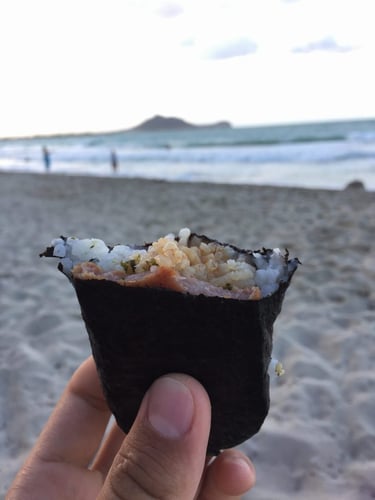Culinary Thinking: Brandon Yung
8/10/20185 min read
Food is so inherently coded into our identities that we oftentimes forget the ability that food possesses to comfort and restore ourselves. In this series of monthly interviews titled "Culinary Thinking," Graphite editor Michelle Kim asks an artist what their favorite recipe is, as a reminder of the food we eat and the loved ones we share it with. For the month of August, Brandon Yung talks about his most recent trip to Hawaii and why he doesn't think he's an artist.
Brandon Yung is an 18-year-old artist who will attend UC Berkeley in the fall majoring in Urban Studies. Brandon is the former Online Managing Editor for Tiger Newspaper and writes for Tunnel Magazine. Brandon enjoys drawing and photography, and especially eating.
Michelle Kim: What do you make?
Brandon Yung: My art functions primarily like a hobby, with little through lines of theme or function that I can think of other than depicting things that interest me. I engage mostly with drawing and photography, either of which I always try to bring with me wherever I go. I wouldn’t venture to call any of my work deep or meaningful, or even myself an artist, but it is something that feels necessary — to be able to maintain a means of creativity and have something I feel I can improve upon constantly. I think my favorite part about creating images is the fact that you have to think nonverbally to do so.
MK: It’s interesting that you don’t necessarily think of yourself as an artist, yet you still see a need to create these images. What is the boundary between artist and image maker?
BY: I think about who gets to call themselves an artist a lot. It feels like everyone who got a Polaroid for Christmas in 2011 could be considered an image maker, and a self ascribed label of artist is as easy as editing your bio. So there is a line, but I am unsure of where to draw it. Maybe it is supposed to be where something isn’t just impressive or pleasurable, where an object becomes art because it engages in some higher level of dialogue with other art, but there are plenty of artists that rate just aesthetically pleasurable things. I guess the only thing I can say toward myself is that I don’t think I have earned it
MK: What informs your art making practice?
BY: I was in Hawaii on vacation recently, a last trip before I move out for college. I had a lot of free time on Oahu, where I would watch the news or bike around. I took a lot of photos and ate a lot of really good food. I love Hawaii, and I am a hapa, which is the Hawaiian word for ‘half.’ In Hawaii, hapas are everywhere, and it is a place that I feel very familiar with, its culture a mosaic of Native people, Japanese and Chinese. The food that best embodies this idea, Hawaii’s history and sheer deliciousness is Spam Musubi.
BY: An innocent slice of cooked spam, sitting atop a warm bed of rice wrapped in a blanket of seaweed, perhaps sprinkled with furikake, sesame seeds or brushed with teriyaki sauce. It’s simple, almost beautiful in its design and humbleness. I feel like somehow I can even identify with the object of a musubi itself, a somewhat awkward obtuse object consisting of this weird combination of ingredients that is markedly Asian-American. It’s history is one of colonization, capitalistic necessity, war, cultural intermixing: a fundmentally Japanese recipe conceived with meat distributed for soldiers fighting in World War II (partially catalyzed by Pearl Harbor in Waikiki). And above all else, it is ono — delicious — a perfectly brick sized portable C4 of umami that, like folk tales, has been passed down by grandmothers for generations.
MK: Do you believe that musubi’s portability contributes to it’s identity as a post WWII food? What other components do you believe distinguish spam musubi from it’s rice-wrapped-in-seaweed counterparts, such as sushi or kimbap?
BY: Spam is a descendant from Japanese onigiri, small rice and seaweed wrapped snacks that are common for school-aged children to eat. Because of unfairly placed import restrictions put on islanders — and the fact that they couldn’t intern all the Japanese-Americans because the economy would have collapsed — spam became a ubiquitous ration food, even more so when fishers were forced to stay on land. As a protein source spam became a part of the local cuisine, combined with the fact that it was an identifiably American product in a politically volatile period, where something as innocent as children’s food could be grounds for suspicion of sedition.
After that period passed, people who grew up eating spam cherished it and continued those culinary traditions. A similar thing happened in Korea, which had a shortage of food supplemented by spam; it is now the second largest consumer of it behind the U.S. I think what’s most interesting though is this love for spam despite the scorn it earned back on the mainland, as people looked at it as lower class.
In the mainland, spam fell into this wheelhouse of kitsch food and American consumerism that is still pretty reviled. I know a lot of people who hate spam but love bacon! We even call our unwanted emails spam! In that sense, Hawaiian culture’s continued appreciation for the canned meat is a metaphor for this sense of cultural authenticity that goes against this American tendency of trying to move away from middle class culture. Spam musubi is authentic. It’s not authentic in the way snobby tourists seek out tea houses in modern day Shanghai. It is similar in it’s delivery to a taco — portable and understandable. Nothing about it is ironic, nor is it considered a dish to be taken seriously by those who love it.
MK: How do you believe this recipe relates to your work?
BY: In a lot of political discussions surrounding cultural appropriation and who gets to cook or wear what, musubi represents to me a damn good argument for American multiculturalism. I look down upon chefs who take from cultures to benefit and draw credit from (Andy Ricker), but as David Chang in his series “Ugly Delicious” comes to argue, there is a beautiful emergent property that happens in the give and take of different backgrounds and traditions. I hate the word “fusion” in cooking, but to pay homage, to love your neighbor or to have history is something to cherish. It is something I have to believe, being mixed myself. I encourage you to appreciate the spam musubi for the same reasons.
Spam Musubi Recipe, as told by Brandon Yung:
*It’s best cooked just feeling out for amounts, so I won’t leave any quantites for ingredients (other than saying a brick of spam is best cut in 8 pieces), so just measure to taste.
Short grain sushi rice, or any rice
Spam
Nori seaweed
OPTIONAL BUT RECOMMENDED
Teriyaki sauce
Brown sugar
Rice vinegar
Furikake or roasted sesame seeds
Cook the rice and once it’s done, add a pinch of sugar and a splash of vinegar to make it like sushi rice. (Fanning it will also help with structural stability). Adjust to taste.
Using a frying pan, cook your spam slices on low until each side is golden and slightly crispy.
Form your rice into nice little bricks, brush on some teriyaki sauce and sprinkle some furikake or sesame seeds, then plop your spam on top of that baby.
Wrap firmly in a properly cut slice of seaweed, seal with a little water, and you got musubi!












